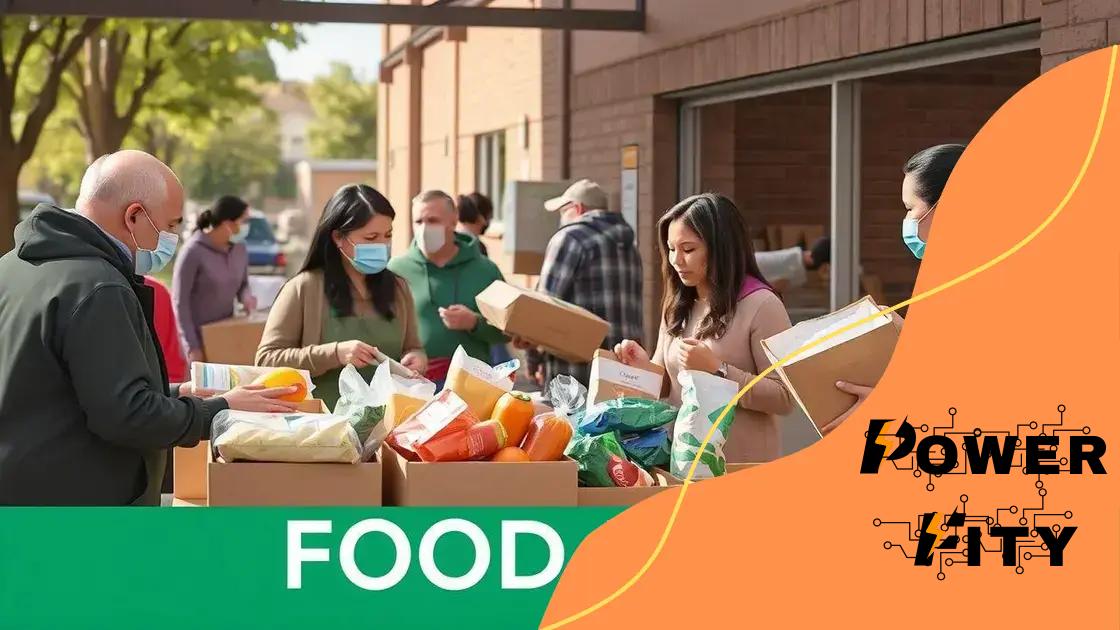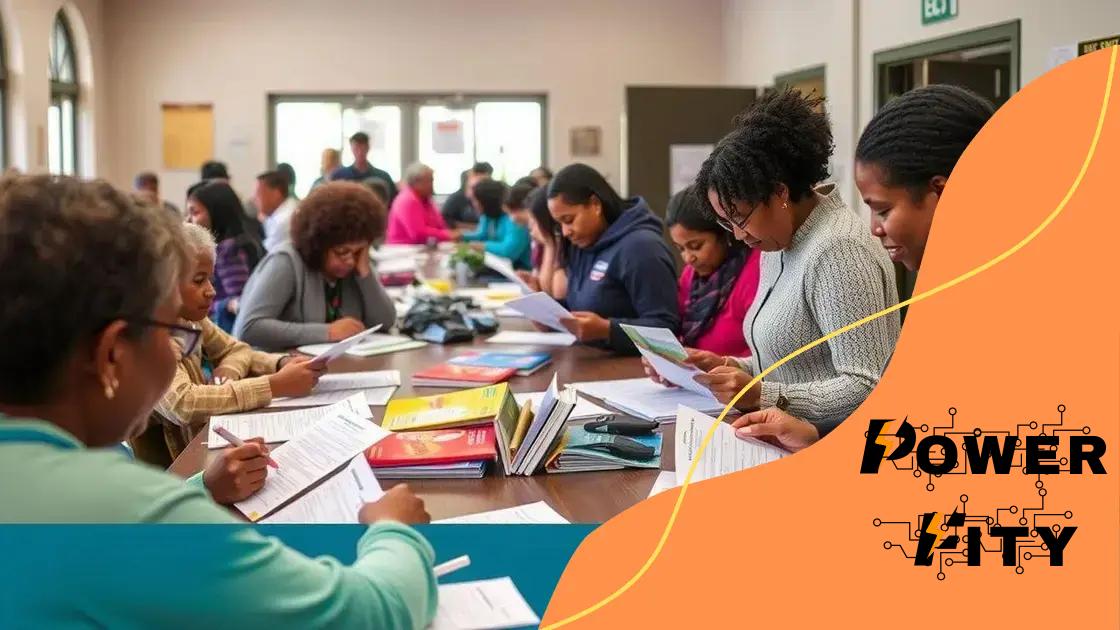Food assistance programs to fight hunger effectively

Food assistance programs provide vital support to those facing hunger by improving access to nutritious food through local resources, government aid, and community programs aimed at alleviating food insecurity.
Food assistance programs to fight hunger are essential tools in our society, helping families secure their basic needs. Have you ever wondered how these initiatives function and who benefits from them? Let’s dive into the details.
Understanding food assistance programs
Understanding food assistance programs is essential for those in need. These programs aim to combat hunger and support families by providing access to necessary food supplies. By learning about how these programs work, you can better navigate the available resources.
What are food assistance programs?
Food assistance programs are government and community initiatives designed to help individuals and families who struggle to afford nutritious meals. They operate on the principle that everyone deserves access to food, regardless of their economic situation.
Types of food assistance available
There are various types of food assistance programs, each addressing unique needs. Common types include:
- Supplemental Nutrition Assistance Program (SNAP): Provides financial assistance to purchase food.
- Food banks: Distribute free food to those in need within the community.
- Community kitchens: Offer free meals to individuals and families.
- School lunch programs: Ensure children receive nutritious meals during school hours.
Many ingredients are local and provided by community donations, ensuring that the supplies are fresh and healthy. Accessing these resources can make a significant difference in the lives of many.
Eligibility for food assistance varies based on income levels and family size. Many programs require documentation, such as proof of residency or income statements. It’s important to check each program’s specific requirements to ensure you qualify.
How to access food assistance programs
Accessing food assistance programs is easier than ever. Many local organizations and government websites provide information on how to apply. Outreach efforts often help connect people with resources in their communities. If you find yourself in need, don’t hesitate to seek help.
Types of food assistance available
There are many types of food assistance available to help those facing hunger. Each program is designed to meet the unique needs of different communities. Let’s explore some key options that can offer crucial support.
Government Programs
Many government programs provide essential food assistance:
- Supplemental Nutrition Assistance Program (SNAP): Offers benefits to buy food at participating stores.
- Women, Infants, and Children (WIC): Provides assistance for health food and nutrition education to pregnant women and young children.
- National School Lunch Program: Supplies free or low-cost meals to students during school.
These programs aim to alleviate hunger and improve nutrition among recipients. It’s important to understand how these programs can benefit families in need.
Community-Based Assistance
In addition to government aid, there are numerous community-based resources:
- Food Banks: Distribute food to those in need through local agencies.
- Charitable Organizations: Non-profits often host food drives and provide meals to low-income families.
- Community Gardens: Promote local food production and provide fresh produce to participants.
These community initiatives not only serve immediate needs but also foster a sense of belonging and support among participants. Many rely on donations and volunteer efforts, making them vital for any community.
Accessing these resources can vary by location; therefore, it is helpful to connect with local organizations for personalized guidance.
Eligibility criteria for food programs

Understanding the eligibility criteria for food programs is crucial for those seeking assistance. Different programs have unique requirements that applicants must meet to receive help. Knowing these criteria can make the application process smoother and more effective.
Common Criteria
Many food assistance programs share similar eligibility criteria that include:
- Income limits: Applicants usually need to provide proof of income, which may not exceed a certain threshold based on family size.
- Residency requirements: Most programs require that you live in the area where you are applying for assistance.
- Citizenship status: Many food assistance programs are available only to U.S. citizens or specific categories of immigrants.
These requirements help ensure that assistance reaches those who need it most. Always check the specific program details for exact criteria.
Application Process
The application process can vary widely. It often involves filling out forms that detail your financial situation, household composition, and residence. Many programs allow online applications, making it easier than ever to apply.
It is important to gather necessary documentation before applying to help streamline the process. Documentation might include pay stubs, tax returns, and identification proof. Remember, providing accurate information helps facilitate quicker decisions regarding your eligibility.
Finally, don’t hesitate to reach out to local organizations for assistance with the application process. They often provide valuable resources and support.
Impact of food assistance on communities
The impact of food assistance on communities is significant and multifaceted. These programs not only alleviate hunger but also promote better health and social cohesion among residents.
Improving Nutritional Access
Food assistance programs improve access to nutritious food for low-income families. When individuals and families can rely on these resources, they are more likely to make healthier food choices. This contributes to overall well-being within the community.
Economic Benefits
Food assistance has economic implications as well. When people no longer have to worry about food insecurity, they can focus on other important areas of their lives, such as education and employment. Additionally, when individuals receive food benefits, they spend that money at local grocery stores, which supports the local economy.
- Job creation: These programs can lead to more employment opportunities in food distribution and local food production.
- Community engagement: Many food assistance efforts involve volunteers, fostering a sense of community.
- Increased awareness: Food programs raise awareness about nutrition and healthy eating habits.
The sense of community grows stronger as residents come together to support and uplift one another. Educational workshops and nutrition programs often accompany food assistance efforts, further enhancing community wellness.
Moreover, food assistance programs can be a lifeline during emergencies, such as natural disasters. Communities that are prepared to provide assistance help their members recover more quickly and effectively.
How to access food assistance services
Knowing how to access food assistance services can make a significant difference for individuals and families in need. The process is designed to be straightforward, allowing those struggling with food insecurity to find help quickly.
Finding Local Resources
The first step is to identify local food assistance programs in your area. Community food banks, pantries, and organizations often provide the necessary support. Online resources such as government websites and local non-profit listings can guide you to available services.
Application Process
After finding a suitable program, the next step is the application process. Many programs offer online applications, which can be convenient. When applying, be prepared to provide personal information such as:
- Proof of income: This can include recent pay stubs or tax returns.
- Identification: Providing a government-issued ID helps verify your identity and residency.
- Household information: You may need to list other household members and their financial situation.
Completing the application accurately will help prevent delays in processing. Some organizations may also offer assistance with filling out applications if you encounter difficulties.
After submitting your application, there may be a brief waiting period while it is processed. During this time, you may want to explore additional resources in case you need immediate support.
What to Expect
Once your application is approved, you will learn about the types of assistance available. This could include food distribution dates, locations, and any eligibility requirements. Many organizations provide helpful staff members who can guide you through the next steps.
Stay informed about follow-up requirements or renewals that may be necessary to continue receiving assistance. Regular communication with the program will ensure you have access to the help you need.
In conclusion, food assistance programs play a vital role in fighting hunger and improving the quality of life within communities. By understanding how to access these services and the eligibility criteria, individuals can get the support they need. Whether it’s through government programs or local organizations, help is available for those who seek it. Remember, reaching out is the first step toward ensuring you and your family have access to nutritious food and support.
FAQ – Frequently Asked Questions about Food Assistance Programs
What types of food assistance programs are available?
There are various programs, including SNAP, food banks, and community kitchens, that help provide food support to those in need.
How do I know if I am eligible for food assistance?
Eligibility typically depends on factors like income, residency, and citizenship status. Each program has specific criteria, so it’s important to check with local resources.
What documents do I need to apply for food assistance?
You generally need to provide proof of income, identification, and information about your household when applying for assistance.
Can I access food assistance during an emergency?
Yes, many food assistance programs are designed to provide immediate support during emergencies, including natural disasters.





